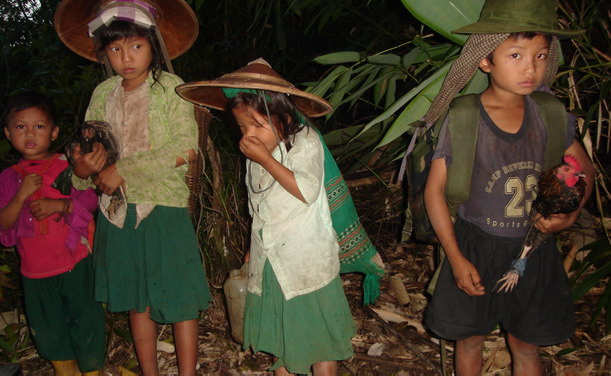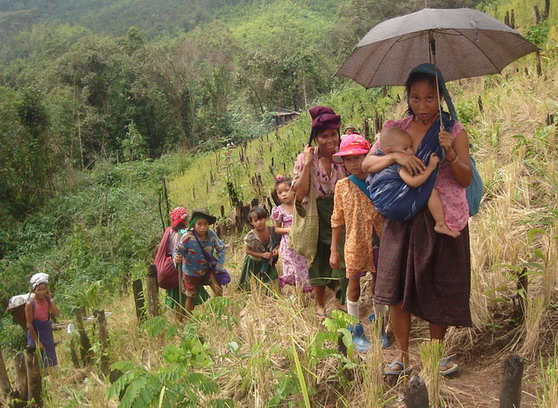|
|

IDPs from Po Mu Der village

IDPs from Ka Ser Do village
(All of the incidents reported occurred in 2006)
10 villages are now on the run from Burma Army attacks.
As of this report the villages of Tha Aye Ki, Ha Toe Per, Klay Hta, Thay Ku Der, Hsaw Wa Der, Hee Daw Kaw, Kgo Ki, Sho Ser, Wa So, and Klay Ki have been forced to flee into the jungle in the face of Burma Army attacks. The villagers from Ha Toe Per, Hsaw Wa Der, and Thay Ku Der are especially at risk now as their hiding places are not far from Burma Army positions.
Villager burned alive by Burma Army soldiers
1 November 2006
Saw They Shur was burned alive by Burma Army soldiers in his home at Play Hta Village, near Hoki. He was 47 years old and married with 6 children. His wife and children are hiding with the other people who escaped the village after it was burned to the ground. He was seriously ill and unable to run and was burned alive in his house at 5:30 p.m. Villagers later saw his dead body in the burned house.
Over 50 reported killed by Burma Army
22 Aug. 2006
Troops from LIB 567, under Myint Thin, shot and killed 3 villagers and wounded one in Klaw Mu Der (Ye Ta Kon) village. These villagers had come back to the village to collect their belongings.
30 Aug. 2006,
Burma Army soldiers killed one Ymeberko villager.
5 Sept. 2006
Burma Army soldiers killed Saw Htoo Bur and his son Saw Baw Bawh in their camp in Shazibo. Burma Army IB 73, camped in Shazibo Village, went to Ze Phu Go village and its surrounding area and looted the villagers’ houses as they went. They found and captured Saw Htoo Bur along with his wife, son, daughter and his brother Saw Hser Mu Eh. They then returned to their camp in Shazibo. They called in two village leaders from Ze Phu Go and Taw Go. They then released Saw Htoo Bur’s wife and brother Saw Hser Mu Eh that evening. Saw Htoo Bur and his son were not released, and it villagers reported that they were killed.
Burma Army Southern Command sent 500 prisoners from Pa La Wah to Kaw Thay Der. Troops from LIB 10 killed 5 of those prisoners. LIB 10 is under Division 66.
Burma Army MOC 16, LIB 55 killed two prisoners in the Noe Soe area.
Burma Army MOC 16, TOC 3, IB 567 and LIB 240 went to Saw Thay Der, Saw Wah Der and Ymeberko villages.
5 Oct. 2006
Burma Army LIB 80 and IB 108 under Division 66 and IB 551 and 35 under MOC 15 began operations along the Kler La–Busakee road. IB 551 and 35 killed over 40 prisoners.
10 Oct. 2006
600 prisoners were moved by the Burma Army from Toungoo to Kler La (Bawgalygyi) to Busakee. These prisoners will be used as porters to support the current offensive against the surrounding Karen villages
1 Nov. 2006
Burma Army troops shot and killed Saw Eh Htoo of Lay Thi village. Saw Eh Htoo was killed at 2:00 am in a home in Kaw They Der village, where he had come for work.
3 Nov. 2006
Troops from IB 35, under battalion commander Soe Htoe, shot two villagers of either Klay Hta or Ha Toe Per village. The shooting occurred between Klay Hta and Ha Toe Per. Villagers from both villages are now in hiding.
Burma Army lays landmines to terrorize civilians
10 Oct. 2006
Four columns from Burma Army MOC 16, TOC 3, IB 240 and LIB 567 entered the Saw Thay Der area and laid landmines. The KNLA Army removed 16 landmines from this area that were laid by the Burma Army.
Burma Army destroys and steals villagers’ property
4 Oct. 2006
Burma Army MOC 16, LIB 567, came into Zaw Mu Der village and stole 660,300 Kyat worth of belongings Saw Mya Say.
1 Oct. 2006
Burma Army MOC 16, LIB 567 and IB 240 destroyed three Saw Thay Der rice paddy fields.
Two columns from LIB 567 looted the belongings of Saw Nay Htoo (60 years old); 3 rings, 1 necklace, 1 pig (20 vises), 200,000 Kyat, 1 Guitar, and 2 boxes of cloth.
They also stole from Saw Pha Gay (35 years old); 1 pot, 2 plates, 20 spoons, 1 pen, and Saw Hta Kay Nay; 20 baskets of rice.
30 Aug. 2006, Burma Army MOC 16, LIB 567 entered Po Mu Der village and destroyed 20 baskets of the villagers’ rice.
On 4 August 2006, Burma Army LIB 4, under Division 66, attacked the Maung Thay Der area and destroyed the villagers’ belongings. The following is a list of the villagers and the total value of their destroyed belongings.
- Saw Hei Klay 100,500 Kyat
- Saw Pu Dei Lu 45,000 Kyat
- Naw Mu Muhh 150,000 Kyat
- Saw Hser Lemer 50,000 Kyat
- Saw Asoe Gay 30,000 Kyat
- Saw Der Day Kywa 150,000 Kyat
These soldiers also destroyed a church and destroyed the villagers’ food stores of rice paddy.
FORCED LABOR/PORTERING
23 Oct. 2006
Burma Army soldiers forced five villagers from Kaw Law Ka, nine villagers from K’Ba Law Kee, five villagers from Htee Tha Bu and three villagers from Ler Gih Ko Der Ka (22 total) to carry food supplies from Thandaung to Kuh Thay Der camp. This was ordered by Burma Army Division 66, TOC 662, IB 105 Major Kyaw So.
21 Oct. 2006
Burma Army Division 66, TOC 662, IB 11, under commander Aung Min forced 12 Beh Kaw Der villagers to carry supplies from Kler La to Maung Ko Der cam. Commander Maung Maung Aye, based in Kler La camp, forced villagers to carry food from Kler La to Busakee. Villagers were forced to carry Burma Army supplies every day.
7 Oct. 2006
Southern Command, LIB 439 commander Kyaw Tun Win forced 8 Shazibo villagers to carry rice to Hti Lo Camp.
2 Oct. 2006
Burma Army Division 66, IB 1 commander Aung Min based in Maung Ko Der camp forced 35 villagers to carry their food rations for them.
1 Oct. 2006
MOC 16 TOC 3 commander Than Tun Oo forced villagers to cut 100 bamboo poles and 100 beams of wood for Play Hsa Lo camp.
29 Sept. 2006
MOC 16 LIB 240 and LIB 567 patrolled through the Saw Thay Der area. MOC 15 LIB 551 patrolled the Tha Htay Kee area, LIB 352 patrolled the Busakee area.
28 Sept. 2006.
Division 66 TOC 662 Operation Commander Pai Soe Thay, based in Kler La (Bawgalygyi) forced 50 villagers from the Thandaung area to move to Kler La.
30 Aug. 2006
Naw Pay Pay and her husband from Zee Pyu Gong village, were captured by LIB 439 for selling diesel fuel. They were forced to go with the Burma Army to Shazibo village. They sent Naw Pay Pay and her husband to Nut Ywa and then to Toungoo Prison.
19 Aug. 2006
Burma Army Southern Command LIB 439 commanded by Kyaw Htun Win from Shazibo Camp forced 16 villagers to carry food to Hti Lo Camp.
Division (66) Commander Maung Maung Aye from Kler La (Bawgalygyi) camp, ordered 12 villages to cut 150 bamboo poles per village to build up the army camp.
15 Aug. 2006
Burma Army Division 66, LIB 10 at Kaw Thay Der (Ye Tho Gyi) forced 10 villagers to carry food from Kaw Thay Der (Ye Tho Gyi) to Noe Soe (Mong Di Gyi) camp.
6 Aug. 2006.
MOC 16, TOC 2, IB 241 and Ta Ba Ka Southern Command attempted to capture 700 villagers in Tha Bin Nyut to carry food for the Burma Army soldiers from Play Hsa Lo camp.
VILLAGE ORDERED TO RELOCATE
3 Aug. 2006 Burma Army MOC 16, LIB 567 entered Pai Taw Dai village. The villagers fled to their farms when the Burma Army came. Burma Army troops then demanded that all villagers move and gave an order that no one was allowed to stay in the village. Many had to leave their belongings behind when they fled and have been too afraid to return home for fear of being shot by the Burma Army. The villagers’ future is uncertain, with no security and hardly any resources.
ENDS
